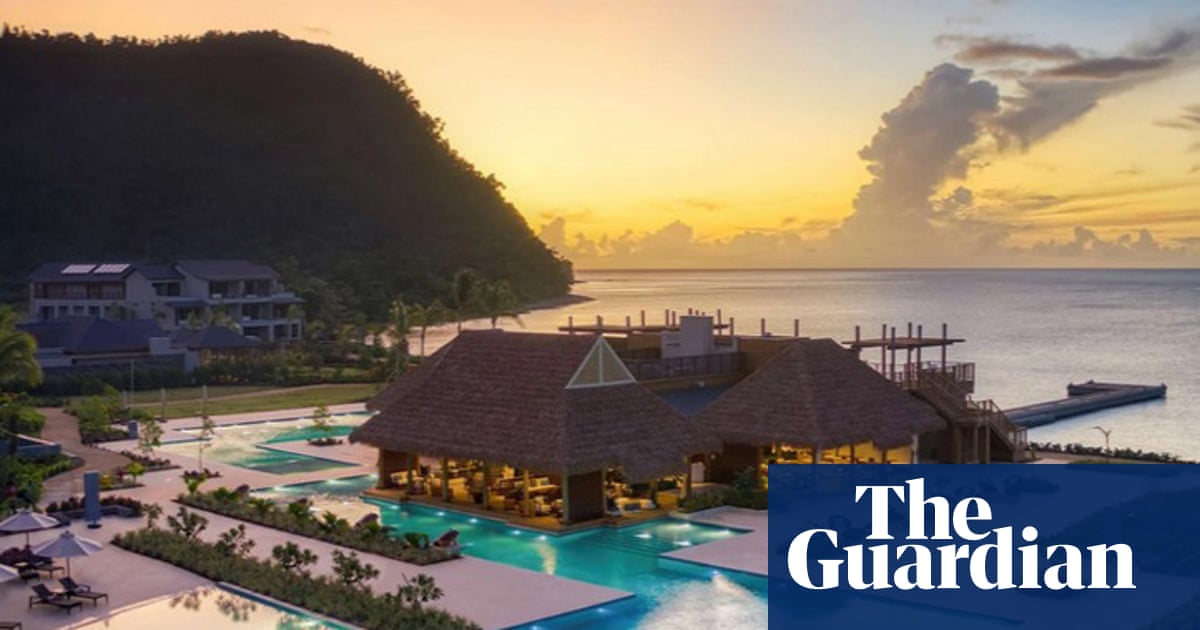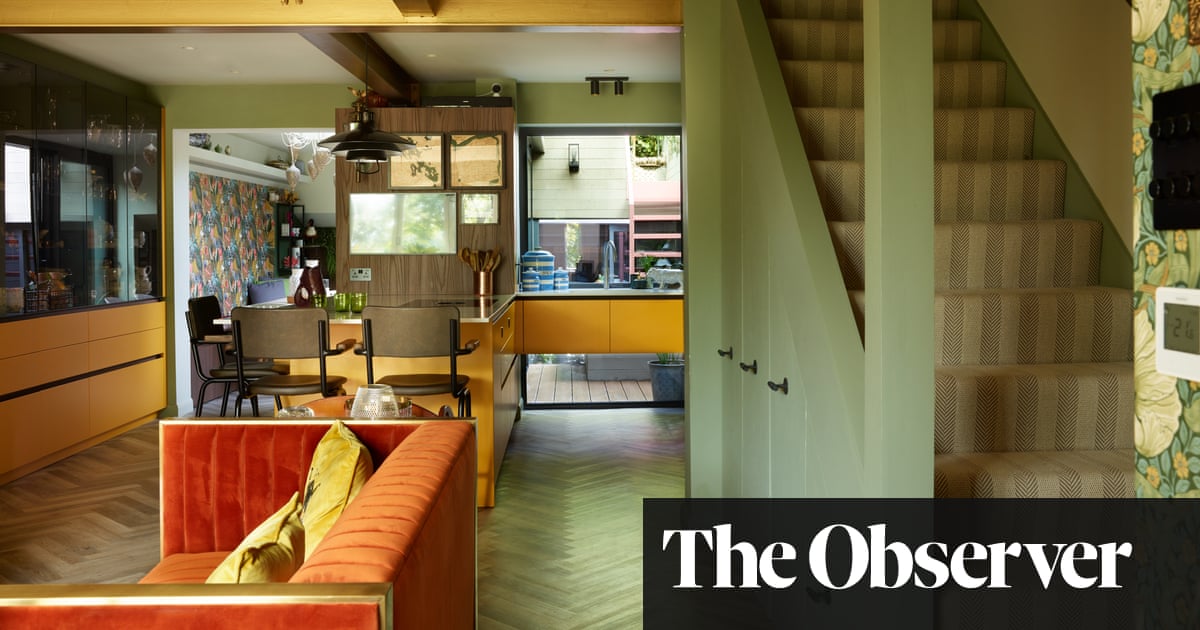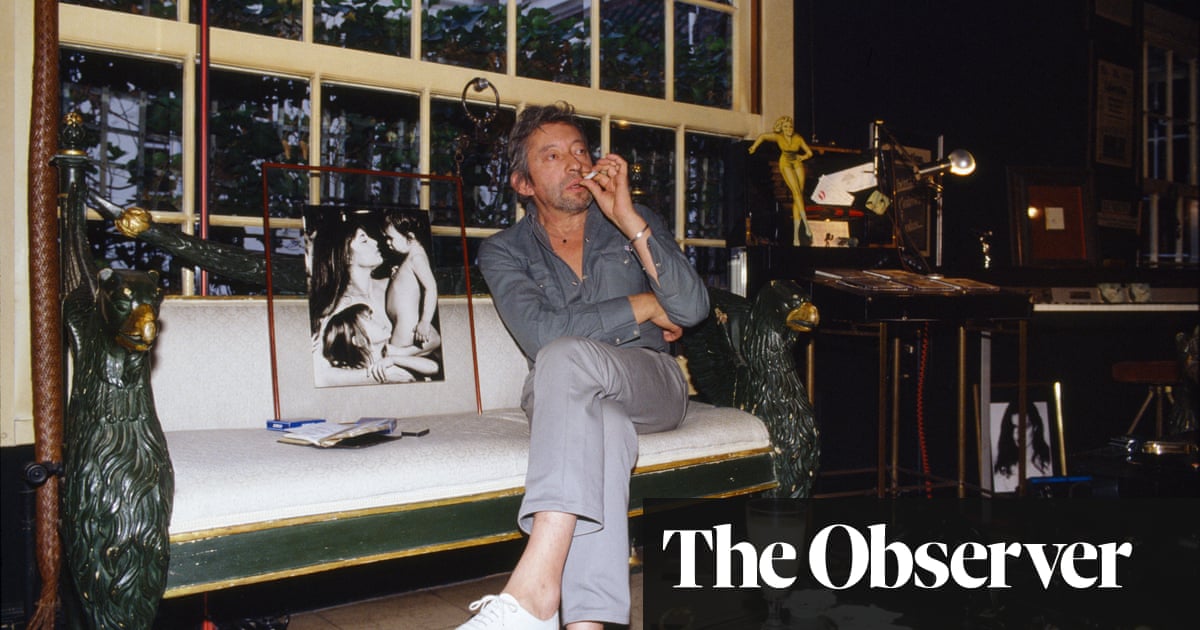
echanical level”, “medical level”, “store level” the voice announces as the lift descends into the earth. I’d entered at parking lot level, the building’s apex. I am travelling through an inverted skyscraper, the floor numbers ascending – third, fourth – as we plumb the building’s depths. A hulking man in his late 50s called Larry Hall stands next to me, whistling, black shirt tucked into blue jeans.
When the doors open, I can’t suppress a laugh. In front of us, four storeys below central Kansas, is a supermarket complete with shopping baskets, cold cabinets and an espresso machine behind the counter. Hall smiles.
“It’s good, isn’t it? On the original blueprint for the renovation, it just said ‘storerooms’ on this level. The psychologist we hired for the project took one look at that and said, ‘No, no, no, this needs to feel like a miniature Whole Foods supermarket. We need a tile floor and nicely presented cases, because if people are locked in this silo and they have to come down here and rifle through cardboard boxes to get their food, you’ll have depressed people everywhere.’”
I am inside the most lavish and sophisticated private bunker in the world: the Survival Condo. It was once a cold war US government missile silo. Constructed in the early 60s, at a cost of approximately $15m to the US taxpayer, it was one of 72 structures built to protect a nuclear warhead 100 times more powerful than the bomb dropped on Nagasaki. Many of these silos were blown up and buried after decades of disuse. But not all of them.
One silo, in Wamego, Kansas, was raided by police in 2000, when they discovered a giant LSD production facility inside, which was generating up to a third of the country’s supply. Another silo, near Roswell, New Mexico, had been turned into an extraterrestrial communication facility which flashed binary code via laser beam into the cosmos. A third silo was funded by William Shatner (AKA Captain James T Kirk of Star Trek fame) to become a commercial research facility for studying the viability of colonising Mars. Yet another silo, in Abilene, Texas, is now a scuba-diving training facility.
Of all the projects that blossomed in the spaces vacated by the state, Hall’s is arguably the most gobsmacking. As an ex-government contractor, property developer and doomsday prepper, with a master’s degree in business, he had the perfect amalgam of attributes to build what had never been done before. In the 90s, he’d worked for a private defence contractor, designing the weapons database for an air force surveillance plane. Later, he moved into constructing hardened data centres. At first, he had planned to build one in a silo; but he quickly realised there was another, emerging market – in doomsday prepping for the super-rich.
Hall bought the $15m silo in 2008 for $300,000. By 2010, he had transformed the 60 metre-deep building into a 15-storey luxury bolthole, where up to 75 people could weather five years inside the sealed, self-sufficient bunker.
Hall knew there would be takers. He had heard about the Silicon Valley elite burying bunkers on ranches in New Zealand, wealthy Russian oligarchs buying whole Pacific islands to escape to, and bunkers being subcontracted by the wealthy (notable examples include Bill Gates and Kim Kardashian). According to a Wired magazine article from 2007, Tom Cruise was planning to pour $10m into building a bunker under his 298-acre estate in Telluride, Colorado. In Los Angeles, a porn production studio even decided to build their new headquarters in an underground bomb shelter – you know, just in case.
In the spring of 2020, public frustration over police brutality led to civil unrest in cities across the US, including Washington DC. At one point, President Trump hid in a bunker underneath the White House, as protesters clashed with police and Secret Service agents outside. In addition to the bunkers that come with the job of president, Trump has bragged about having bunkers under his estate in New York, his golf course in Palm Beach and the nearby resort, Mar-a-Lago. The latter is undergirded by a bunker built in the early 50s by breakfast cereal magnate Marjorie Merriweather Post. Back in 2007, Trump told a journalist for Esquire that he’d spent $100,000 “fixing up” the bunker at the golf course and in the event of a calamity, the Mar-a-Lago shelter is where he’d want to be.
Lavish bunkers such as these are built not so much in response to a single imminent catastrophe, but out of a more general disquiet about a variety of threats. Preppers dread nuclear war and accidents, a collapsing ecosystem, runaway technology, pandemics, natural disasters, economic meltdown and violence.
Waiting out these disasters may require a few years. It’s not that difficult to imagine living underground for a short-term lock-in. What’s more of a challenge is to create a psychologically tolerable environment for the long haul – in order, not to put too fine a point on it, that the members of this newly troglodytic community don’t murder each other.
During the early days of the cold war, governments, the military and universities conducted numerous experiments to see how long people could withstand being trapped underground together. In total, in the early 60s, about 7,000 people volunteered to be locked in spaces with groups ranging from the size of a family to more than 1,000 people, as part of the US government’s attempts to assess the psychological impact.
In one study by the University of Georgia, researchers locked groups of men, women and children aged between three and 70 in fallout shelters six times between 1962 and 1964 for varying periods, during which they had to subsist on bulgur wheat crackers and water. They had no bathing water, bunks or blankets. The researchers “found that no deleterious psychological or social effects occur from two-week periods of group confinement under austere conditions”.
It seemed people could adapt – just so long as they knew the situation was temporary. The study suggested that when citizens needed to hunker down, the preparation required was less important than the need to “prepare them for immediate adjustment to the post-attack world upon emergence”.
Another report, published by the US National Science Foundation in 1960, suggested that extended time underground “may involve many physiological deprivations”, including “difficulties in concentration, irritability, depression and personality disturbances”. In other words, people might survive, but they wouldn’t thrive. It would only be a matter of time before disquiet, and worse, started rippling through the group.
Hall, however, thinks he has worked out a solution to these potential obstacles. The key to wellbeing underground, he tells me, could be about creating an illusion of normal life. “So we will have people baking bread and making coffee, people can advertise their yoga class on the cafe blackboard, and we’re going to stack this deli case full of three different species of tilapia that are grown in the aquaponics facility next door.” The nitrates from the fish droppings will fertilise soil for the plants in the FDA-certified aquaponics facility. The fresh produce from here will end up in the general store. Leftover vegetable matter, fish heads and bones will be put through a grinder to become food for the residents’ dogs and cats – including Lollipop, Hall’s cat, who is happily roaming around the silo four storeys above us. “It’s critical that we encourage people to come down and shop and be social,” Hall says, “because obviously everything in here is already paid for.”
Money, in other words, will have no value in the Survival Condo – which is just as well, given the bankruptcy-inducing prices of buying into it in the first place. Half-floor apartments here are $1.5m (£1.2m); full-floor apartments $3m (£2.4m); and a two-level, 3,600 sq ft penthouse has sold for $4.5m (£3.6m). In total, 57 people will be living in 12 apartments, each paying an additional $5,000 (£4,000) a month in residents’ association fees. One apartment, bought with cash, is designed to feel like a log cabin, with a loft looking down on a fake fireplace flanked by a six-screen display of a snow-capped mountain range.
None of those buying into the bunker are in residence at the time of my visit. Other than me, Hall, Lollipop and the on-site maintenance guy, there is no one inside. Unsurprisingly, the residents are elusive and tight-lipped. One is Tyler Allen, a real estate developer from Florida. Another is Nik Halik, from Melbourne, a “thrillionaire” adventurer and wealth strategist, who has flown on a civilian mission into outer space and dived to the wreck of RMS Titanic.
***
For much of my life, the word “bunker” has conjured up a mental image of a crumbling concrete second world war monolith, a pillbox on a beach, slumped in the sand, covered in graffiti. There’s no doubt that during the 20th century, the bunker became a ubiquitous form of architecture in response to the threat of air power. However, it has deep roots in human history. In Cappadocia, in the Central Anatolia region of what is now Turkey, there are 22 known large-scale ancient subterranean cities, dug in around 1200BC. Many still exist. Archaeologists believe that Derinkuyu, the deepest of the 22, reaches 60 metres below the surface and sheltered as many as 20,000 people, along with their livestock and food stores. It consisted of more than 18 floors of bedrooms, halls, churches, armouries, storage chambers, wells and toilets.
In recent years, bunkers have become not just spaces for human bodies but a place from which to revive things we care about. The US Library of Congress, for instance, has adapted a massive bunker in Virginia and filled it with its film, television and sound collections. The goal is to prevent another terrible loss such as the torching of the Great Library of Alexandria 2,000 years ago.
On level 11 of the Survival Condo, about 50 metres underground, Hall and I visit a 1,800 sq ft home. I have had the same feeling as walking into a bedroom in a hotel chain. The apartment has never been used. It has a Navajo print rug, a cushy white sofa set and a stone electric fireplace with a flat panel TV over it. A marble countertop extends to a bar separating the living room from the kitchen, which is filled with high-end appliances. I look at one of the windows and am shocked to see it is dark outside. My instant, physiological reaction is to assume we must have been underground for longer than I thought. Then I realise my mistake.
“Got you,” Hall says, laughing. He picks up a remote control and flicks on a video feed being piped into the “window”, a vertically installed LED screen. The scene depicted is the view from the front, at the surface-level entrance of the condo. It is daytime, breezy and green outside. I can see my car through the branches of an oak tree, exactly where I’d parked it a few hours earlier. But when this video was made is not necessarily obvious – maybe there is a time lapse and I am watching a prerecorded past I am convinced is the present. The thought sends a prickle of unease down my spine.
After lockdown, Hall could choose precisely which material to share with the other occupants. Their sense of context, of reality, of what’s happening above ground – whether or not the world has ended – is entirely in his grip. “Most people prefer to know what time of day it is than to see a beach in San Francisco, though,” he says casually, flicking the feed off again. The screen goes blank.
Hall is not just experimenting with new technology; he is thinking about how to control people’s thoughts and reactions. I know he was once a “spook” and worked as a government contractor. I wonder if this whole thing has actually been funded by the Department of Defense as a human Petri dish, the next iteration of those 1960s cold war human experiments. Not telling the residents they are partaking in an experiment would be the key to its rigour.
But Hall explains that he lived in the bunker for a month before the “window system” was installed. It was, he says, like living in a casino. Unable to confirm that the passing of time correlated to what his clocks were telling him, or who was coming or going outside the bunker, he felt totally isolated. The LED screens changed all this, by reintroducing a circadian rhythm.
One of Survival Condo’s residents, the one with the two-storey “penthouse”, has bought into this idea. She has filmed Central Park from her Manhattan loft, during all four seasons, day and night, together with the cacophonous sounds of urban life. To accommodate this year-round record on video, Hall and the maintenance man ground down the cement wall of the silo and slathered it with reflective paint. Then they built a balcony with a railing and, using a $75,000 (£60,000) throw projector, made it appear as if the resident could step on to the balcony to look over the city through sliding glass doors.
“The psychologist drilled into me that my job is to make this place as normal as possible,” Hall says. “No one wants to be reminded all the time that they are basically living in a submarine. Come on, I’ll show you the life support system.”
We take the lift up to the mechanical level, just below the surface, where Hall waves me over to a reverse osmosis filtration system. Water is pumped out of 45 100 metre-deep subterranean geothermal wells. Ten thousand gallons of water a day can be filtered into three electronically monitored tanks which each hold 25,000 gallons.
We move down to level three, where Hall keys a code into a thick steel door. He opens it to reveal something like the scene from The Matrix in which Neo and Trinity zap into the boundless arsenal to choose their wares. “This is one of three armouries,” Hall announces proudly. “In each one we’ve got sniper rifles, ARs, helmets, gas masks, first aid kits and non-lethal weapons such as military-grade pepper spray.”
But, he continues, “the armouries might not even be needed. Outside is a .223 remote-controlled rifle. You can kill people like it’s a video game.” Hall opens up another key-coded bulletproof door to reveal a massive bank of screens and a control panel with a joystick. He explains that, although they have thermal, night and full-spectrum cameras inside and outside the entire facility, the rifle can be put into automated defence mode firing three-round bursts at anything that comes into its field of view.
“We can also hit them with three-round bursts of paintballs,” he says. “That will make it clear what comes next, if they keep moving toward the condo.”
The joystick is part of a larger multiscreen control panel called Kaleidoscope, a basic AI system capable of closing off parts of the bunker automatically in the event of, say, a fire. If that puts you in mind of 2001: A Space Odyssey, and the possibility that Kaleidoscope could start trapping people and hitting them with three-round bursts, you’re right in sync with me at this point.
Hall pauses and takes a deep breath. “Look,” he says, “the fact is, this was not a space of hope. The defensive capability of this structure existed only to the extent that it was needed to protect a missile. This bunker was a weapon system. We have converted a weapon of mass destruction into the opposite. This is a safe, self-contained, sustainable experiment in architecture – it’s a subterranean equivalent of the University of Arizona’s Biosphere project.”
The project, better known as Biosphere 2 (because Biosphere 1 is Earth), was an experiment in environmental sustainability and one of the most ambitious projects in communal isolation ever orchestrated. In 1991, in Oracle, Arizona, a crew of eight – four men and four women – locked themselves inside a glass dome to see if they could survive in a closed system for two years. The experiment, which took place on a three-acre complex in seven “biomes” under glass, was fruitful, but plagued by social division, and poor oxygen levels that led to extreme fatigue and even banana theft, after disappointing crop yields in the biome led to rationing. This sounds funny until you imagine food vanishing while being locked in a building with starving people.
Biosphere 2 taught us a lot about how humans act under extreme pressure. Paradoxically, for a project in ecological sustainability, it was funded by oil money. It was also taken over before the second mission by Steve Bannon, Trump’s former chief strategist, who carried around a copy of The Fourth Turning, the book by William Strauss and Neil Howe about apocalyptic rebirth.
Both Biosphere 2 and Hall’s silo, I realise, might signal a pivot in architectural history. Both are outliers that point towards the “normalisation” of the bunker experience. Rather than being just for an apocalypse of some kind, these technologies, and the social systems needed to keep them humming along, are being trialled and tweaked long before they are needed.
Our tour continues. Like a burly Willy Wonka, Hall leads me past the climbing wall, air hockey and table tennis, and a pet park complete with artificial grass sandwiched between a fake tree and a sunny mural set in the Rocky Mountains. He opens a door and flips a light switch to illuminate a 50,000-gallon steel swimming pool flanked by a rock waterfall, lounge chairs and a picnic table. A mural of a tropical beach is painted on the wall behind it.
We get back in the lift and hit the button for the cinema level. “Going down,” the lift says, taking us to almost 200 feet below the surface of the Earth in 20 seconds, zipping past a dozen condos on the way, including Hall’s on level five.
The cinema is on the penultimate level, sitting atop water pumps and storage. It has terraced leather recliners facing a large screen. We settle in and raise the leg rests as Hall cues the opening credits of Skyfall, his favourite of the 007 franchise. He shouts over the soundtrack that we are immersed in 7.4 THX surround sound and a 4K video projection. After a few minutes of this, Hall ushers me into the adjoining aircraft-themed bar. One of the residents has donated 2,600 bottles of wine from her restaurant to stock it.
Leaning on the bar, Hall explains that the psychologist he hired also worked on Biosphere 2. “She went over everything in meticulous detail. From the acoustics to the textures to the colours on the walls. Even the LED lights in the bunker are set to 3000 Kelvin [a warm white] to prevent depression. People want to know why residents need all this ‘luxury’ but what they don’t get is that this isn’t about luxury. This stuff is key to survival. If you don’t have all this stuff built in, you start to get varying degrees of depression or cabin fever.”
Hall expands on his theme. “In fact, everyone needs to work, generally. People on vacation constantly get destructive tendencies. That’s just human nature. You need to have a four-hour minimum workday and rotate jobs, so people don’t get bored and break things,” he says.
In building these spaces, there’s an implicit assumption that we have given up on fixing the world we broke. You might imagine the resources invested in building these underground redoubts might be better spent trying to address the catalysts for disaster. But this is why we should pay attention to private bunkers: they are a reflection of how deeply our dread has saturated us.
The tour over, we head back to the surface. After only a few hours in that hermetically sealed environment, the warm sun on my face and the smell of the trees and grass give me an overwhelming sense of having walked into a painting animated through some mysterious force.
***
I began writing up this experience when I was in Sydney, Australia. By the time I left, the country was in the midst of catastrophic wildfires. A billion animals burned to death. In January 2020, the suburb of Penrith in western Sydney reached 48.9°C, making it the hottest place on Earth. When I landed back home in California, the plane descended into a haze of smoke emanating from wildfires surrounding Los Angeles, blurring the distance across the Pacific. I’d returned with my partner to care for my mother, who needed spinal surgery. My mother was discharged hastily, just as the Covid-19 pandemic began to tendril into the US. As we lifted her from the wheelchair to the car, tents were being erected behind us in the car park of Torrance Memorial hospital for the expected patient overflow. The three of us ended up holed up in our own Los Angeles bunker of sorts for months. As the virus spread, supply lines, international travel and trade routes, economic systems and social norms collapsed over a matter of weeks. The pandemic was precisely the kind of breakdown preppers were preparing for.
• Bunker by Bradley Garrett is published by Allen Lane on 4 August at £20. To order a copy for £17.40, go to guardianbookshop.com. Bradley Garrett and Robert Macfarlane will be in conversation about Bunker in a virtual event for 5x15 on 12 August.












